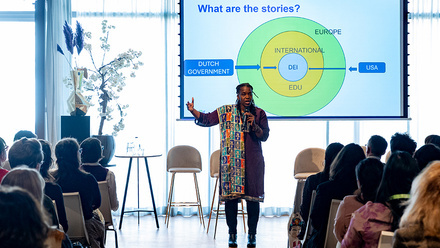Breaking the silence: encompassing Roma voices in Europe

In our discussions of inclusion in mobility, we frequently focus on certain forms of exclusion, oftentimes based on race. However, this approach – which is rooted in US-centric conceptions of race and inclusion – can exclude certain voices from the conversation, such as those of the Roma people. Illuminating another aspect of this year’s conference theme, ‘Encompassing all voices’, Michael Woolf implores us to break our historic silence on the persecution of the Roma.
International academic mobility is often preoccupied with selected forms of exclusion, particularly those defined by race. When it comes to study abroad involving US students, this focus unintentionally reinforces notions of American exceptionalism, as if the conditions of the United States – in which race is the default distinction – are of global significance. But projecting the fractures within US society beyond its borders creates a myopic and sometimes distorted view of the realities of other regions. In Europe, for example, significant minorities become barely visible if viewed through the lens of race.
Indeed, in US education abroad, Europe tends to be presented as a region of enlightened cosmopolitanism, a more inclusive, more tolerant environment than that of the US. However, that idea of Europe is not the experience of the Roma (also known as ‘Romani’ and often traditionally referred to as ‘Gypsies’). Many Roma have been, and are, subject to exclusion, discrimination and persecution in countries where sizable numbers of US students spend time studying abroad: Austria, Czech Republic, England, Finland, France, Germany, Hungary, Ireland, Italy, Sweden and elsewhere. Yet, the Roma are largely absent in the narrative of Europe that we – sending and receiving institutions alike – present in education abroad. They rarely figure in discussions of diversity and have been uniquely invisible and passed over in the battles for civil rights over the last 60 years. They are a people paradoxically ignored and vilified.
"Bigotry and hatred are not the most urgent problem. The most urgent, the most disgraceful, the most shameful and the most tragic problem is silence."
Blindness to persecution and discrimination is dangerous myopia. The words of Rabbi Joachim Prinz on August 28, 1963 in the March on Washington retain a contemporary relevance:
Neighbor is not a geographic term. It is a moral concept. It means our collective responsibility for the preservation of man's dignity and integrity […] in Berlin under the Hitler regime, I learned many things. The most important thing that I learned […] was that bigotry and hatred are not the most urgent problem. The most urgent, the most disgraceful, the most shameful and the most tragic problem is silence (Starkman).
Which leads to a key question:
Who are these people?
Generalising about any group of people is potentially perilous. In the case of the Roma, those perils are multiplied: Romani experience significantly differed and differs according to the policies and practise of the countries from which they came and in which they find themselves. Further, there are, as with any people, internal divisions and distinctive groups who may or may not have a sense of affinity. There is, for example, no single religious affiliation.
There is some consensus on distant origins. Roma originated in Northern India and first arrived in Europe at the end of the 13th century. Waves of migration were motivated by a range of factors and conditions. The Roma were both nomadic and refugees; a historical paradox that shapes the constructed identities imposed.
For over 700 years, the Romani people have been defined by what has been done to them rather than by what they have done. Heinrich Himmler decided that the Roma were a "race" which paved the way for their inclusion in the ‘final solution’. The post-war German authorities decided that they were not a race and, thus, did not qualify for reparations or any other alleviation of the consequences of deadly persecutions.
Nomadism, cosmopolitanism and mobilities
Romani identity, like many others, is not single or simple. We are all shaped by ambiguities. We are all also shaped by the ways in which others have imagined us.
The notion that the Roma are predominantly nomadic does not stand up to the evidence. A history of forced expulsion and deportation suggests that Roma have been more commonly refugees than nomads. However, the recurrent characteristic is the idea of a nomadic people – although only a very small minority of the Romani population are nomadic – who are represented as rootless, without national allegiance, frequently spies, aliens who carry with them disease: like the Jews, an affront to patriotic ideals.
In Roma experience, mobility has more frequently represented a lack of choice, constriction of freedom
The Roma are a nation of some kind, but they are not defined by shared geographical space nor do they cohere around a notion of home or land myth: conventional measures of nationhood. There are many difficulties associated with statistical information about the Roma. For good reasons, they have resisted inclusion in official census reports, given that identification has often been a prelude to persecution.
Romani experience makes notions of mobility problematic. In international education mobility is a gateway to opportunity, a privileged journey towards enrichment and the broadening of landscapes. In contrast, in Roma and Jewish experience, mobility more frequently represented a lack of choice, constriction of freedom, less going towards some desirable objective and more about escape from intolerable situations.
Obscured and hidden histories
There are inevitably points of comparison and distinction between the Roma and other groups who have suffered discrimination and persecution, most notably the Jews and African Americans. The single and most obvious (though perhaps least known) connection between Roma and African Americans is a shared legacy of slavery.
Indeed, the Roma were victims of two of the most heinous abuses in human history: slavery and the Holocaust. However, they have been footnotes in the narratives of these atrocities.
Somewhere between 500,000 and a million Roma were victims of the Holocaust, nearly 50% of Europe’s entire Romani population
This, despite the fact that up to 600,000 Romani were enslaved under Ottoman rule in what is now modern Romania until emancipation in 1864. They were divided into house and field slaves, were subject to arbitrary sale and barely restrained punishments. The parallel with the enslavement of Black Americans is unavoidable. There are more distant resonances with the slavery of the Jews in Egypt. The obvious and glaring difference is that the Bible tells of the Jews and libraries of memoirs and histories describe slavery in the US. Accounts of the Roma experience, however, are much less numerous and have mostly been written within the last 50 years.
But, their suffering has been epic in nature. Somewhere between 500,000 and a million Roma were victims of the Holocaust, something near to 50% of the entire Romani population of Europe.
Those who laid the foundation for the Roma Holocaust were not punished or disgraced. Instead, they went on after the war to fulfil roles in academia and public service. There was no outrage. No Roma gave evidence at Nuremberg; no sustained or systematic pursuit of the guilty happened. There was no sense that this slaughter was part of an ongoing historical experience; that it was consistent with a narrative that continues to this day to challenge our humanity.
What there was instead was shameful silence.
Today, if the (international) education experience we offer in Europe is to genuinely ‘encompass all voices’, this silence must be broken.






